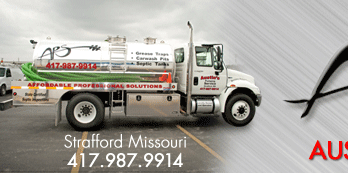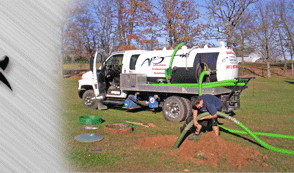Q. What is a grease trap?
A. A grease trap is a chambered box attached to the outlet side of a sink & equipment drains. The chambers (usually screens) slow the flow of wastewater allowing the Fats, Oils and Grease {called FOG} to cool and rise to the surface. The solids settle to the bottom and the remaining water flows out through the sewer system.
There are two types of grease removal devices, one is a large outdoor underground grease interceptor and the other is a smaller indoor grease trap. The large outdoor grease interceptors are generally made out of concrete and located under manholes outside the restaurant. The smaller indoor grease traps are boxes that are generally located in the sink area, either above ground or in the floor.
BACK TO TOP
Q. What if I don't clean the trap regularly?
A. Improper cleaning and maintenance can cause FOG's and food solids to flow into the sewer pipes and harden beyond the trap causing major plumbing issues that require expensive repair bills and business down time. Also, most municipalities can levy fines for improper maintenance.
BACK TO TOP
Q. How is a grease trap cleaned?
A. The grease trap must be emptied of all FOG's, water and food solids. The screens must be scraped and rinsed, as well as the trap interior. The outlet box must be clear of waste. The trap should be refilled with water and tested for proper flow. The removed waste must be properly disposed of and exterior deodorized and cleaned.
BACK TO TOP
Q. Are fats, oils and grease a problem?
A. Yes. Fats, oils and grease (FOG) cause serious problems in the sewer system pipes. It sticks to the sewer pipe walls and restricts the wastewater flow, which can cause blockages that could result in sewer overflows. This requires pipes to be cleaned more frequently and may cause some pipes to be replaced sooner than expected. Clogs and overflows can create smelly, dirty messes - possibly damaging your business, property, profits, as well as the environment.
BACK TO TOP
Q. What types of products contain fats, oils and/or grease (FOG)?
A. Cooking oils, salad dressings, sandwich spreads, meat, lard, shortening, dairy products, sauces, butter/margarine, are just some examples.
BACK TO TOP
Q. Why should my business be concerned about keeping FOG's out of the sewer?
A. Doing all you can to prevent grease-related sewer blockages and overflows benefits your business, your pocketbook and the environment by:
• Avoiding expensive clean-up costs and penalties
• Avoiding the loss of business due to a sewer back-up
• Keeping the environment clean
BACK TO TOP
Q. What can I do to keep FOG's out of the sewer system?
• Train employees on the proper disposal of FOG and the hazards of washing FOG down the drain.
• Post Proper Disposal of FOG Best Management Practices signs near sinks and dishwashers.
• Wipe or scrape pots, pans, dishware and work areas into trash to remove FOG and food residues before washing.
• Use mild water temperatures (120 F to 140 F) in all sinks, especially in pre-rinse sinks.
• Install or use easily cleaned and removable drain screens in all sink drains, floor drains, kitchen sinks, mop sinks and hand sinks to capture solid materials. The screen openings should be 1/8" to 3/16".
• Clean exhaust hood filters in sinks, not outside.
• Block off sinks, floor drains or storm drains near any FOG related spill and clean up using absorbent materials, such as absorbent sweep, cat litter or paper towels. Place used materials in a separate sealed bag before placing it in the trash.
• Prevent outdoor spills and overflows from entering the storm drain by creating barrier using dirt,
cat litter or other absorbent material to contain the spill or overflow until all grease is cleaned.
• Frequently clean indoor grease traps and, when possible, supervise all cleaning and maintenance of outdoor grease interceptors to ensure the devices are properly maintained.
BACK TO TOP
Q. Does a grease trap / interceptor prevent blockages?
A. YES! Grease traps / interceptors do help prevent blockages downstream of the trap / interceptor, but blockages can (and do) occur if the trap / interceptor is not cleaned often enough. A grease trap / interceptor which is not cleaned will eventually clog.
BACK TO TOP
Q. Why does my grease trap / interceptor back up and overflow? If I buy a new one will it back up and clog less?
A. Most commonly, grease traps / interceptors back up either because they need to be cleaned and or the grease trap / interceptor is too small for your sink which can causes an outlet to be blocked. If you buy a large unit you will need to clean it less often because it will hold more grease. All grease traps / interceptors will clog if you don't remove the grease regularly.
BACK TO TOP
Q. What does the flow control do and where does it go?
A. The flow control regulates and aerates the flow of water going into the grease trap allowing the F.O.G. to separate. The flow control should be placed as close to the source of water as possible, but after the solids interceptor if present.
BACK TO TOP
Q. Must the flow control fitting always be used?
A. Yes! If the flow control is not installed, the grease trap may not function properly, and greasy water could pass through to the plumbing system.
BACK TO TOP
Q. Why is grease a problem?
A. Grease is a problem because it doesn't dissolve in water. Large amounts of oil and grease in the wastewater block the pipes. These have to be cleaned more often and replaced sooner than necessary. Sometimes, the buildup of grease in the system can block sewers and flood basements. Oil and grease also affect the treatment process at the wastewater treatment plant.
|












